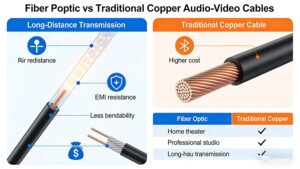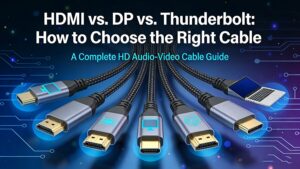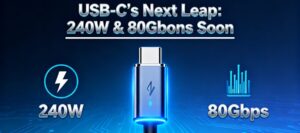USB 3.1 Am to Type C Optical Fiber Data Cable: A Comprehensive Analysis
1. Introduction
The evolution of data transmission technologies has been marked by significant advancements in speed, efficiency, and reliability. Among these, the introduction of USB 3.1 and Type C connectors has revolutionized the way devices connect and communicate. The integration of optical fiber technology into these connectors further enhances their capabilities, offering unprecedented data transfer speeds and signal integrity.
2. Technical Specifications and Standards
USB 3.1 and Type C Specifications
USB 3.1, also known as SuperSpeed+, offers data transfer rates of up to 10 Gbps, doubling the speed of its predecessor, USB 3.0. The Type C connector, characterized by its reversible design, supports USB 3.1 and is capable of delivering power, data, and video through a single port.
Optical Fiber Specifications
Optical fibers are thin strands of glass or plastic that transmit data as light signals. They offer several advantages over traditional copper cables, including higher bandwidth, longer transmission distances, and immunity to electromagnetic interference.
Compatibility and Interoperability
The integration of optical fiber technology into USB 3.1 and Type C connectors requires adherence to specific standards to ensure compatibility and interoperability with existing devices and infrastructure.
3. Advantages of Optical Fiber Over Copper Cables
Data Transfer Speed
Optical fibers can transmit data at speeds significantly higher than copper cables, making them ideal for applications requiring high bandwidth.
Signal Integrity and Noise Immunity
Optical fibers are immune to electromagnetic interference, ensuring that the data transmitted remains intact and free from noise and signal degradation.
Distance and Bandwidth Capabilities
Optical fibers can transmit data over longer distances without loss of signal quality, making them suitable for applications that require long-range communication.
4. Applications of USB 3.1 Am to Type C Optical Fiber Data Cables
Consumer Electronics
In consumer electronics, optical fiber data cables are used to connect devices such as smartphones, tablets, and laptops, enabling high-speed data transfer and charging.
Industrial Applications
In industrial settings, these cables are used for data communication between machinery and control systems, ensuring reliable and fast data transfer.
Data Centers and Cloud Computing
Data centers and cloud computing environments benefit from the high bandwidth and low latency offered by optical fiber data cables, facilitating efficient data storage and retrieval.
5. Design and Implementation
Structural Design of the Cable
The design of USB 3.1 Am to Type C optical fiber data cables involves the integration of optical fibers with the connectors, ensuring robust and reliable connections.
Materials Used
High-quality materials, including glass or plastic optical fibers and durable outer sheaths, are used to ensure the longevity and performance of the cables.
Manufacturing Process
The manufacturing process involves precise alignment of the optical fibers with the connectors, followed by stringent quality control measures to ensure the performance and reliability of the cables.
6. Performance Evaluation
Testing Methodologies
Performance evaluation involves testing the data transfer speed, signal integrity, and durability of the cables under various conditions.
Comparative Analysis with Traditional Copper Cables
Comparative analysis with traditional copper cables highlights the advantages of optical fiber in terms of speed, signal quality, and distance capabilities.
Real-World Performance Metrics
Real-world performance metrics provide insights into the practical applications and benefits of using optical fiber data cables in various scenarios.
7. Challenges and Solutions
Technical Challenges in Design and Implementation
Technical challenges include ensuring precise alignment of the optical fibers, maintaining signal integrity, and achieving compatibility with existing devices.
Cost Considerations
The cost of optical fiber data cables is higher compared to traditional copper cables, but the benefits in terms of performance and reliability justify the investment.
Future Advancements and Potential Solutions
Future advancements in optical fiber technology and manufacturing processes are expected to reduce costs and further enhance the performance of these cables.
8. Case Studies and Market Analysis
Case Studies on the Deployment of Optical Fiber Data Cables
Case studies highlight the successful deployment of optical fiber data cables in various industries, demonstrating their practical benefits and applications.
Market Trends and Demand Analysis
Market analysis indicates a growing demand for high-speed data transmission solutions, with optical fiber data cables gaining popularity in various sectors.
Future Prospects
The future prospects for optical fiber data cables are promising, with ongoing advancements in technology and increasing adoption across industries.
9. Conclusion
The integration of optical fiber technology into USB 3.1 and Type C connectors represents a significant advancement in data transmission technology. The benefits of higher data transfer speeds, improved signal integrity, and longer transmission distances make these cables ideal for a wide range of applications. As technology continues to evolve, the adoption of optical fiber data cables is expected to increase, driving further innovation and improvements in data transmission capabilities.







